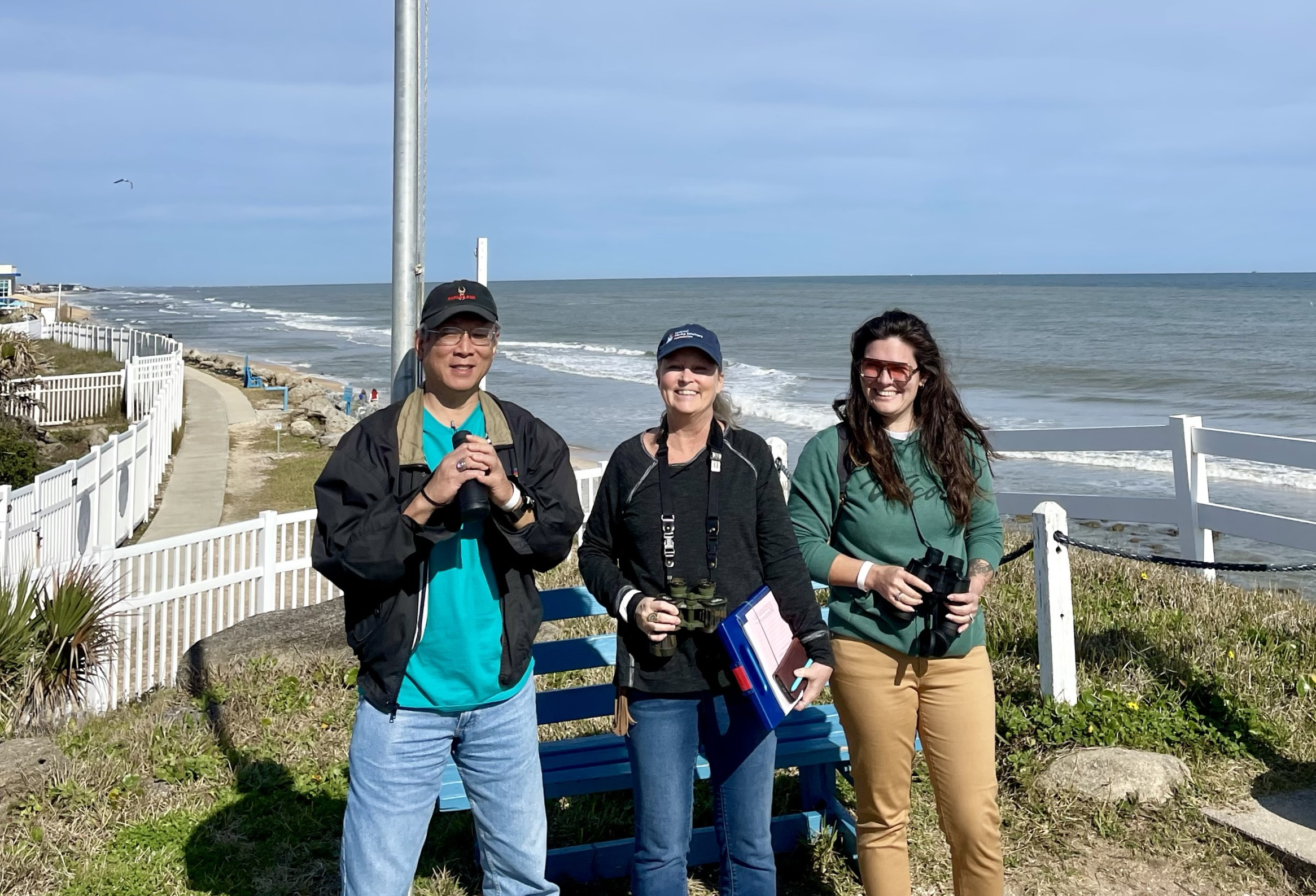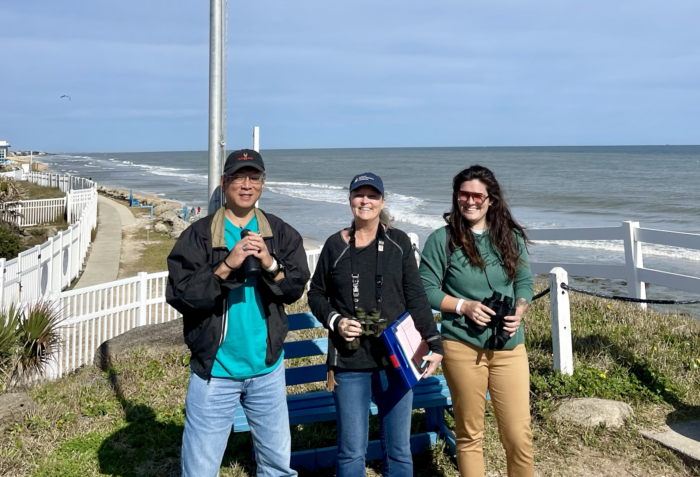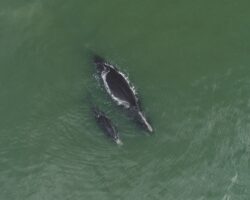
A Community Scientist’s Tale: Watching for North Atlantic Right Whales

Steve Yeh, Erin Jaszczak, and Nicole Gardner monitoring for right whales from Submarine Pointe, FL. Photo credit: Erin Jaszczak
Written by: Erin Jaszczak, Senior Program Operations Manager, Marine Debris, for the National Marine Sanctuary Foundation
On Sunday mornings, I watch for whales – specifically, North Atlantic right whales. This critically endangered species, with only about 370 left in the world, joins the annual migration of “snowbirds” visiting Florida during the winter months. From shore, with binoculars around my neck and a data collection sheet in hand, I scan the water for the v-shaped mist of their exhale. I’m here volunteering as a community scientist for the Marineland Right Whale Project as part of a growing community of concerned individuals supporting the scientists committed to the conservation of these majestic ocean giants. We may not be professional scientists, but as community scientists, we play a vital role in the effort to save one of the ocean’s most endangered species.

Right whale mother Halo and her second calf, Jagger, off Flagler Beach in 2020. Halo has a new calf this season. Photo credit: Marineland Right Whale Project, NOAA Permit #26562)
Right whales were named during the period of whaling when they were deemed the “right whales” to hunt because they spent long periods near the surface, swam slowly, and floated once killed. While commercial whaling is no longer a threat, these gentle giants continue to face threats including entanglement in fishing gear, ship strikes, habitat degradation, and climate change-induced changes to their food sources. Our 2024 field season orientation started on a high note with several new calves spotted. But in January 2024, a juvenile female (#5120) was found dead off the coast of Martha’s Vineyard with fishing gear deeply embedded in her tail. Most recently, female #1950 was found dead off the coast of Virginia with catastrophic injuries consistent with a vessel strike. This mother had a calf that hasn’t been seen since and is not expected to survive without its mother. With only about 70 breeding females remaining, these losses are exceptionally devastating. In early March, I experienced one of my most difficult moments as a community scientist. Our Sunday observation team was informed in our briefing that Juno (#1612) had been spotted near our sector the day prior without her calf. Our work that day included monitoring for the calf’s carcass. The hope we had been holding out for the calf’s survival since first being spotted with severe vessel strike injuries was diminishing, and later that day would be crushed when the remains of the calf washed ashore off the coast of Georgia. Though grief-stricken, I’m grateful for the opportunity to be out here, doing something proactive in the effort to ensure this majestic species is not forever lost to the world.
Community science, sometimes referred to as crowdsourced science, is a collaborative approach where volunteers partner with scientists to support research and conservation efforts that answer real-world scientific questions. By engaging the community in scientific projects, community science harnesses the power of large-scale data collection, fosters public awareness and understanding of science, and encourages community involvement in addressing real-world issues. In this way, curious and concerned people like myself and my fellow volunteers can make a difference.
The Marineland Right Whale Project was founded twenty-four years ago by Senior Scientist Jim Hain of the Associated Scientists of Woods Hole. For this project, volunteers aid in monitoring the presence of whales along the Atlantic coast of Florida. Every day, for ten weeks between January and March, teams volunteers head out on four-hour shifts to patrol 50 nautical miles of coastline between St. Augustine and Ponce Inlet. (Meet the NARW Citizen Scientists: Last of the Right Whales.) Equipped with a vehicle, cell phone, binoculars, clipboard, and survey/sighting forms, we travel up and down our sectors to visit designated observation points along the coastline. We collect data including time, weather and water conditions, and observations of activities happening on the water. We hand out brochures and share information with curious beachgoers. And we watch. If we’re lucky enough to have a sighting, it’s phoned into the scientists and reported to a state agency that deploys planes for aerial observations of the whales and alerts vessels in the area in an effort to avoid ship strikes like the one that claimed the life of the Juno’s calf. The results of the field season are publicly available by visiting www.aswh.org.
Being a community scientist watching for North Atlantic right whales is not just a hobby, it’s an opportunity to be a part of a community of like-minded individuals united in a common cause that brings a profound sense of purpose and fulfillment. This season, the Marineland Right Whale Project had a record 260 volunteers who contributed 8,000 volunteer hours. Many of these volunteers have been a part of the project for years, and a few since its inception 24 years ago. A good number continue to winter in Florida just to be a part of the project. Together, we share an experience that fosters a sense of camaraderie and collective action that transcends our diverse backgrounds.
My journey to the Marineland Right Whale Project began with a simple curiosity about the availability of volunteer opportunities in my area. But it’s not my first experience volunteering as a community scientist. I’ve also enjoyed participating in underwater and shoreline marine debris removal projects and coral conservation efforts. The availability of interesting projects even afforded me the chance to work on one from home, listening to underwater acoustic recordings to identify various sounds as part of ADRIFT in the California Coast. Clearly, I’m drawn to ocean-based projects, but the variety and abundance of community science opportunities available means there is something for just about every interest.
Our right whale season recently ended, and as I gaze out across the vast ocean, I’m reminded not only of its fragility but also of its resiliency. I’m buoyed by the news that 19 right whale calves were born this season, the highest number in the past decade, and I’m inspired to continue contributing to conservation through community science.
Interested in exploring community science? Check out these resources:
- National Marine Sanctuaries and partner community science programs. The diversity of projects includes monitoring coral reefs and cleaning coastlines, seabird and fish counts and watching for whales, analyzing acoustic data, and identifying manta rays.
- SciStarter.org’s Project Finder tool to search through thousands of vetted community science projects.
- There’s an app for that! Technology has increased accessibility and the ability to crowdsource data collection. One I keep on my phone is iNaturalist which allows anyone to contribute to biodiversity research simply by uploading their nature photos.
For news on North Atlantic Right Whales, visit NOAA NARW and NARWC.org.
